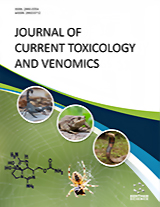Abstract
Customary firework burning during different festivals and occasions have
been reported from different parts of the world. The pollutants emitted from fireworks
exert toxicological effects on human health and the environment. A virtual study was
performed to assess the extent of binding of sixteen important components of fireworks
including Al2O3
, Ba(NO3
)2
, C6H6
, CO, Ethylbenzene (C8H10) Fe2O3
.H2O, KClO3
, KClO4
,
KNO3
, Na2C2O4, NH3
, NO, o-Xylene (C8H10), SO2
, Sr(NO3
)2
and Toluene (C7H8
) with
human superoxide dismutase (SOD), human serum albumin (HSA), and estrogen
related receptor gamma (ERR-gamma) proteins. AutoDock 4.2.6 was employed to
perform rigid docking. Against HSA, NH3
exhibited the least binding energy i.e. -5.19
kcal/mol. Against ERR-gamma, Al2O3
showed the least binding energy i.e., -4.08
kcal/mol. With SOD, ethylbenzene exhibited binding energy of -4.62 kcal/mol. A
molecular dynamics simulation of 10 ns was performed on the ERR-gamma-o-xylene
complex at 300K at the molecular mechanics level using GROMACS 5.1.2., showing
conformational changes within the protein due to the o-xylene binding. The average
Root Mean Square Fluctuation of the complex was 0.0821 nm. The results can be
further elaborated and may guide future research for the intervention of protein targets
for chemical toxins.
Keywords: Air pollution, Health, Hazard, Virtual screening, Protein










